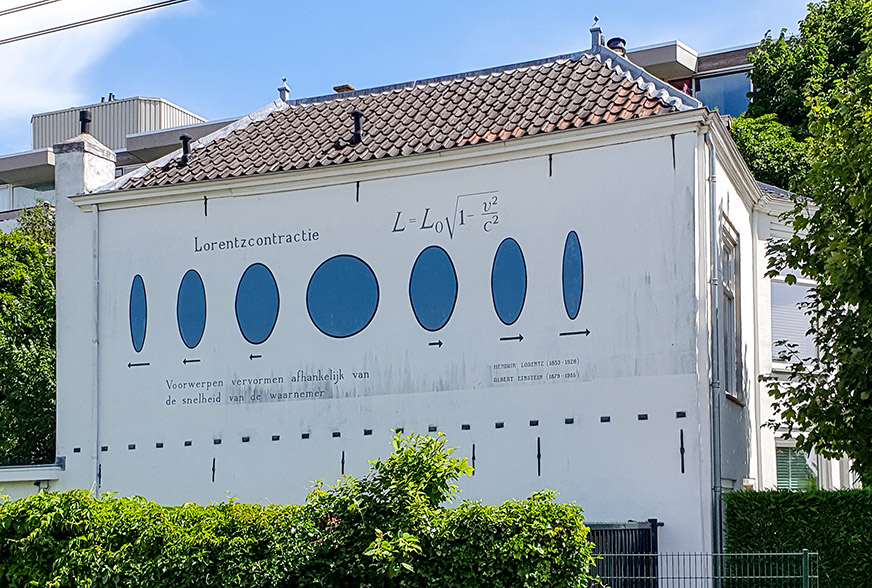Lorentz-FitzGerald contraction, also called space contraction, in relativity physics, the shortening of an object along the direction of its motion relative to an observer. Dimensions in other directions are not contracted.
www.britannica.com
Imagine you have a really fast spaceship traveling at a significant fraction of the speed of light, let's say 90% of the speed of light (that's extremely fast!). Now, you have a measuring tape on board that spaceship, and you want to measure the length of something, let's say a pole or a ruler, that's stationary relative to the spaceship.
Here's where things get interesting. According to the theory of special relativity proposed by Albert Einstein, when an object moves at high speeds, strange things happen to its measurements as observed by someone outside the spaceship (an observer on Earth, for example). One of these strange effects is called the Lorentz contraction.
The Lorentz contraction tells us that when an object moves at a very high speed relative to an observer, its length appears to be shorter than its actual length when it's at rest. In other words, the measuring tape on the fast-moving spaceship will show a shorter length for the pole or ruler compared to what someone on Earth would measure for the same object.
To the people on the spaceship, everything seems normal, and they would measure the length of the pole just like they would at lower speeds. But to an observer on Earth watching the spaceship zip by at 90% of the speed of light, the pole would look squished or contracted in the direction of its motion.
This might sound a bit strange, but it's a real and well-tested phenomenon! It's essential to understand these relativistic effects when dealing with incredibly fast-moving objects and it's a critical part of EINSTEIN's theory of special relativity. The Lorentz contraction is just one of the many fascinating and mind-bending consequences of traveling at relativistic speeds.
the Lorentz Contraction
- What: as part of the Leiden Wall Formulas
- Why: Lorentz was physics professor in Leiden. Apart from the Lorentz contraction he made a number of other important discoveries. He described the Zeeman effect together with Pieter Zeeman, for which they received the Nobel Prize in 1902. Earlier, he discovered the Lorentz force, which provides a theoretical explanation for the Zeeman effect.
- What: Hendrik Lorentz (1853 - 1928)
Albert Einstein (1879 - 1955)
Although this all happens at almost the speed of light, I can imagine, visualise in my mind, this effect very well with for instance a passing train.
Another effect, which might look the same but is something different altogether, is Jacques-Henri LARTIGUE's photo of a racing car:
"whizzing past blurred onlookers"
The shutter of Lartigue's camera was a horizontal slit, moving from top to bottom. Also, he moved his camera, while taking the picture, with the direction of the racing car. This made the wheel disforming to the right and the spectators falling to the left. No idea, whether this effect was intentional or an interesting coincidence.
- title: Le Grand Prix A.C.F.,
- Who: Jacques-Henri LARTIGUE (French, 1894–1986),
- What: Gelatin silver print:
- Where: © Victoria & Albert Museum, London
- When: 1913 (made), later (printed)
- interesting link: See for a full explanation and slideshow: www.connolly-cleary.com
WIKIPEDIA: "Born in Courbevoie in western Paris to a wealthy family, Lartigue started taking photographs when he was seven. He photographed his friends and family at play – running and jumping; racing home-built race cars; making kites, gliders as well as aeroplanes; and climbing the Eiffel Tower. He was one of the first artists to use the Kodak Brownie camera for snapshots. He also photographed sport events, such as the Coupe Gordon Bennett and the French Grand Prix, early flights of aviation pioneers such as Gabriel Voisin, Louis Blériot, Hubert Latham, Louis Paulhan and Roland Garros. He also captured in his camera, tennis players such as Suzanne Lenglen at the French Open tennis championships. Many of his initial, famous photographs were originally captured in stereo, for example seen in Hidden Depths but he also produced a vast number of images in all formats and media including glass plates in various sizes, autochromes, and film.
Hint: He developed his own photographs from a young age."
wikimedia


